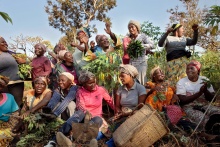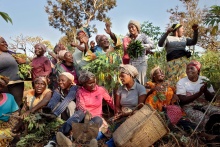Climate change and its deluge of devastation, in the form of epic floods, droughts, wildfires, and temperature changes, is no longer a tale of some hypothetical apocalyptic future. Between 2000 and 2019, according to UN Women’s gendered analysis of the impact of climate change on poverty, productivity, and food insecurity, global flooding caused USD 650 billion in economic losses, affecting 1.7 billion people and resulting in more than 100,000 deaths. Meanwhile, severe dry spells are becoming more frequent and prolonged. Recent projections show that the number of drought days could increase by more than 20 per cent in most of the world by 2080.
Op-ed: Building women’s resilience to climate-driven poverty and food insecurity
Bearing the brunt
Women and girls from impoverished and marginalized communities bear the brunt of these devastating climate impacts. A study conducted by UN Women on why climate change matters for women found that women living in arid areas or in areas that experienced frequent and severe droughts were more likely to experience child marriage, adolescent births, and hardship associated with collecting water and cooking with unclean fuels. For them, these climate hazards are not mere inconveniences but existential threats to life, livelihoods, and hopes for a better future.
As climate change intensifies, women’s health and well-being are increasingly threatened. According to UN Women’s estimates, in a worst-case climate scenario, by 2050 as many as 158 million women and girls may be pushed into extreme poverty as a direct result of sustained increases in global temperatures. Food insecurity caused by climate change is also projected to increase by as much as 236 million more women and girls. Sub-Saharan Africa, with a projected increase in female poverty of 93 million and an increase in female food insecurity of 105 million, is anticipated to be among the regions most impacted. The second largest spikes in absolute numbers of female poverty and food insecurity are projected to take place in Central and Southern Asia. There, under a worst-case scenario, 29 million more females will be pushed into poverty and 57 million more into food insecurity by 2050.
Yet, amid this bleak picture, there is a glimmer of hope. Indigenous communities, the guardians of our planet’s most pristine landscapes, have long called for a different approach to development. They advocate for a path that values and protects nature as an equal to us, its human inhabitants. In many countries, laws are evolving to protect the environment and all beings that depend on it. In India, for example, the courts increasingly recognize natural resources like glaciers, rivers, and mountains as entities needing protection and, as a result, have granted them personhood status under the law. Other countries, including Bangladesh, Colombia, Panama, and Uganda, as well as other communities and local governments, are enacting similar laws with a focus not only on the “rights of nature” but also on the duties and obligations of humans to protect it. Women at the forefront of these efforts, as it turns out, not only have the most to lose but are also the most active in the collective efforts to combat climate change.
Enhancing women’s role in conservation efforts
As women and men engage with the environment differently, they also play differentiated roles in environmental conservation and degradation. For instance, according to a 2022 national survey on gender and the environment in Tonga, men were more likely than women to apply pesticides when performing agriculture (67 per cent versus 43 per cent). Men (18 per cent), more so than women (6 per cent), also said they were applying more pesticides to cope with climate change. Interestingly, even when women apply pesticides, they are more likely to adhere to label directions to mitigate risks and to use organic sources of nutrients instead of fertilizers.
Gender differences are also evident in forestry or fishing activities, where conservation measures are few and far between. Fewer than one in three people use sustainable forest management practices in Tonga, and men (22 per cent) say that they are more likely than women (16 per cent) to replant and repopulate. This is a finding that needs more exploration, but it might be tied to women having less capital, land rights, or the financial capacity to put money back into their land holdings. The Tonga survey highlights the importance of delving deeper into how gender norms can impact environmental behaviours and coping strategies. These insights are vital for implementing effective and practical solutions to the climate and biodiversity crises.
Managing fisheries, forests, land, and other natural resources sustainably is essential to halt biodiversity loss and the effects of climate change on women’s and men’s health and livelihoods. Still, women are often underrepresented in environmental decision-making. Globally, only 15 per cent of women engage in climate related ministries, 18 per cent in forests, and 11 per cent in water and irrigation ministries. Locally, in many countries, their representation is even lower. Inequality in land rights and land ownership, in many places a precondition for having a say in resource management, is also relevant. Women globally own a mere 14 per cent of agricultural land and, in many countries, their access is being further undermined by environmental degradation and land grabbing.
Conclusion
Understanding gender differences regarding the environment and guaranteeing the rights of women and girls are essential stepping-stones toward protecting our planet. Women, in all their diversity, must have equal access to environment-related decision-making for solutions to be inclusive and durable. Data and research on climate change and environmental conservation must mainstream gender, capturing both the gendered effects of the changing climate, particularly among those furthest behind, and the differentiated role of women and men in environmental conservation and degradation. To this end, improving the production and use of statistics on the gender–environment nexus is critical to tackle the triple planetary crisis effectively. Informed decisions must be made to invest in gender-responsive climate mitigation and adaptation and build a more resilient future.

